Ableton Move aims to be the perfect hardware sketchpad for Live
The battery-powered hardware device can control Live, but also runs its own OS based on Ableton Note
After having teased its arrival earlier this month, Ableton has finally unveiled its latest hardware device. Move is a compact controller and instrument that – like the latest version of Ableton’s flagship controller Push – can operate both tethered to Live and as a standalone device, thanks to an onboard CPU and rechargeable battery.
Although it shares some obvious characteristics with Push, Move actually has more in common with the company’s iOS sketchpad Note. In its standalone mode, Move runs an onboard OS that closely resembles the workflow of Note. This allows the unit to run up to four tracks, each of which makes use of a version of one of Live’s Instrument Rack or Drum Rack devices.
These Racks make use of a limited selection of Live instruments and effects to produce both melodic and percussive sounds. The Drum Racks can contain 16 instances of the Drum Sampler device, which was recently added to Live 12.1, while the Instrument Racks can each contain a single instance of either Drift, Wavetable or Live’s Melodic Sampler. Each Rack can host two effects, one send and one insert, chosen from a limited selection of Live devices.
READ MORE: Ableton Move review
Patterns can be programmed using Move’s grid of 32 polyphonic pressure-sensitive pads, or via the button step sequencer along the rear of the unit. Both playing and automation can be recorded, overdubbed or recalled using Live’s Capture functionality.
Although, on the whole, the sounds offered by Move are largely preset-based, all sounds can be customised using the parameters controlled by a bank of eight touch-sensitive rotaries along the top of the unit.
Move also features onboard sampling capabilities. Users can sample via a built-in mic, a 3.5mm audio input on the rear of the unit, or by resampling the main output. It’s also possible to import samples via either a wired connection or Move’s onboard WiFi.
Get the MusicRadar Newsletter
Want all the hottest music and gear news, reviews, deals, features and more, direct to your inbox? Sign up here.

On that front, Move offers a number of methods for users to take ideas started in standalone mode for further development in Live. This can be done using the browser-based Move manager – again accessible via either wired or wireless connection – or by using Ableton Cloud, which lets users transfer Move projects to Note or Live.
Along with its standalone capabilities, Move can also function as both a controller for Live whereby its pads, sequencer and rotaries can be used to play and edit Live’s devices, trigger clips and input patterns. Move also functions as a USB interface.
The hardware itself has a fairly minimal range of I/O. The rear panel has 3.5mm jacks for audio input and output, which are joined by two USB ports. The first, a USB-C port, is used for power and connection to a host computer, the second, USB-A, is used for connection to MIDI devices. According to Ableton, Move’s onboard battery life is around 4-hours. It can also sync with other devices via Ableton Link.
Move is available now priced at £399/$449/€449. Find out more at the Ableton site.


I'm the Managing Editor of Music Technology at MusicRadar and former Editor-in-Chief of Future Music, Computer Music and Electronic Musician. I've been messing around with music tech in various forms for over two decades. I've also spent the last 10 years forgetting how to play guitar. Find me in the chillout room at raves complaining that it's past my bedtime.










